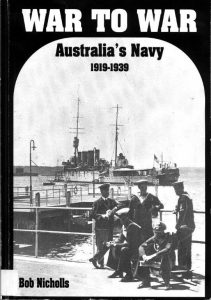- Author
- Book reviewer
- Subjects
- Book reviews, History - Between the wars
- Tags
-
- RAN Ships
- None noted.
- Publication
- June 2013 edition of the Naval Historical Review (all rights reserved)
War to War: Australia’s Navy 1919-1939 by Bob Nicholls. Australian Military History Publications, Sydney, 2012. ISBN 9780 98077451. rrp $35. (02) 9542 6771

Bob Nicholls died in 2010. After serving for 23 years with the Royal Navy, Bob joined the RAN only in 1968, but nevertheless managed to produce a series of excellent books on his adopted navy, beginning with Bluejackets and Boxers in 1986. His special areas of interest were those aspects of the RAN and its predecessors that had been inadequately examined in the past, and his final contribution to our historiography stayed with that theme.
There has been very little researched and presented on the RAN and its vicissitudes from the return of the Fleet from overseas in 1919-20 to the outbreak of the Second World War, in comparison with more ‘exciting’ periods in its history. The outline is familiar, but Bob’s careful research and insightful prose demonstrates how little we have understood about the machinations that accompanied the decline of a proud and powerful Fleet to a small and unbalanced Squadron, barely worthy of the term ‘operational’, in the depths of the Great Depression. The Australian navy’s climb out of these depths back to a modicum of operational respectability in a few short years is a remarkable one which has not previously received its due regard from historians.
Bob is unrelenting in laying the blame for the difficulties which confronted and confounded the RAN between the wars on the inadequacies of the Naval Board and its too-easy resort to advice and assistance from the British Admiralty. What the Board needed to do was to study and develop a corpus of thought on an Australian naval viewpoint, which took due account of the practicalities of the naval defence of the nation 12,000 miles from Whitehall. The threadbare nature of the ‘Singapore strategy’, with its dependence on the successful passage of a British battle fleet to the Far East should a Japanese threat to British interests – and those of the Dominions – emerge, was recognised and acknowledged by Australia’s naval planners, but they failed to come up with an alternative strategy. As British senior officers seconded to the Australian navy, arguably not a career-enhancing prospect at the time, perhaps they had little imperative to do so.
The personnel issues that bedevilled the RAN in the immediate aftermath of the Great War, leading to several instances of indiscipline ashore and afloat, are unflinchingly described. These were concerning enough to prompt the RN to consider whether the agreed exchange of midshipmen should proceed lest their young officers become contaminated by it. There was certainly enough for the lower deck to complain about, but the incidents were unconnected and limited to a few individuals: unlike the RN, the RAN would not suffer the ignominy of a Fleet-wide mutiny in 1931. By then the development of an Australian naval ethos and improved leadership from an increasingly Australian officer corps had brought the causes of grievances under effective control.
Bob observes, however, that the other aspect of this dependence on the Royal Navy was overwhelmingly beneficial for the fledgling Australian navy. Its officers and men received the same specialist training as their RN counterparts and many applied and developed these skills in complement billets within the larger navy.
On the rare occasions when it was possible for a ‘cruiser exchange’ to be effected, Australian ships served and trained within the ambit of a larger British fleet – frequently acquitting themselves well – and developing the abilities and competence which would soon be called upon from 1939 onwards. Throughout this period of peace, the graduates of the first entries to the RAN College progressed towards positions in command of Australian ships, and the cadres of senior sailors who would provide the backbone of the navy developing after 1933 and who would train the wartime expansion force were also being nurtured within the British system.
Satisfactory though these developments were, there were other less positive events. The RAN’s two flirtations with submarines in the period 1919-1930 were ill-conceived, poorly-planned, short-lived and expensive. The RAN chronically dragged its feet in providing its agreed oil fuel stocks for Imperial use, and Cockatoo Island Dockyard’s inability to meet its delivery schedules for ships was a serious concern to the Navy and the government. This didn’t stop the politicians ordering the seaplane carrier Albatross to keep the yard afloat, a bizarre expedient which worked, however, to ensure that Cockatoo was there when it was needed in the coming years. The onset of the Great Depression was to make matters worse for all, and Squadron training and exercising virtually ground to a halt.
And while this is a book about the RAN, Bob has included some comparisons with the state of the other two services in these difficult years. The Navy might have felt under pressure, but it was immeasurably better off than the Army and Air Force in organisation, equipment and personnel in the lead-up to World War II. Sound decisions made in plenty of time would ensure that the Australian navy was ready to fight on 3 September 1939 and went on to display its skills with great distinction in all theatres of war. It was a very different and more professional service than had straggled home from Europe in 1919.
War to War has some editorial short-comings, but it an entertaining read for expert and layperson alike and a valuable addition to our knowledge and understanding of a crucial time in the development and history of the RAN. It can take its place with pride with the other outputs of the remarkably inquiring and insightful mind of Robert Michael Nicholls.
Reviewed by Ian Pfennigwerth




